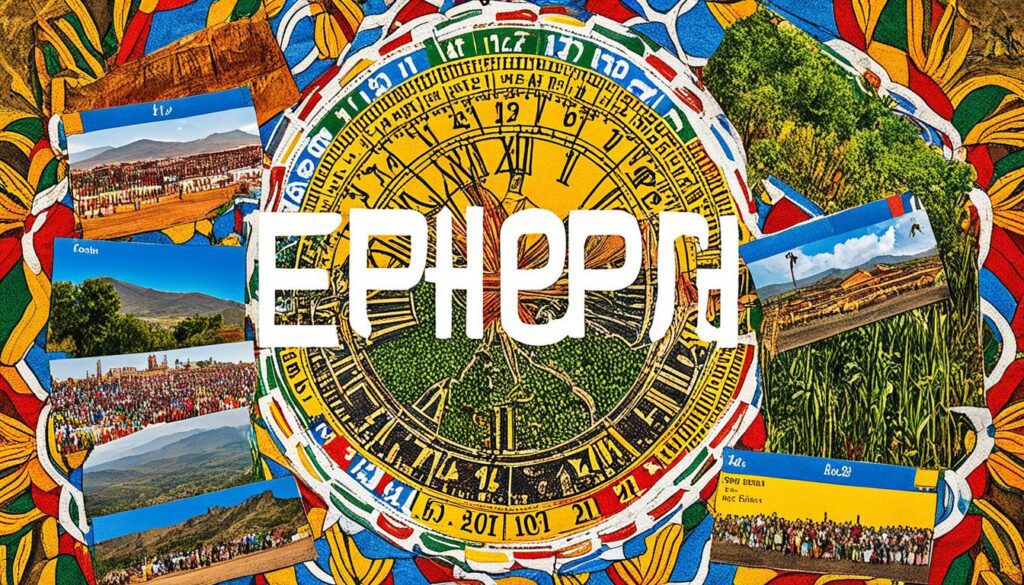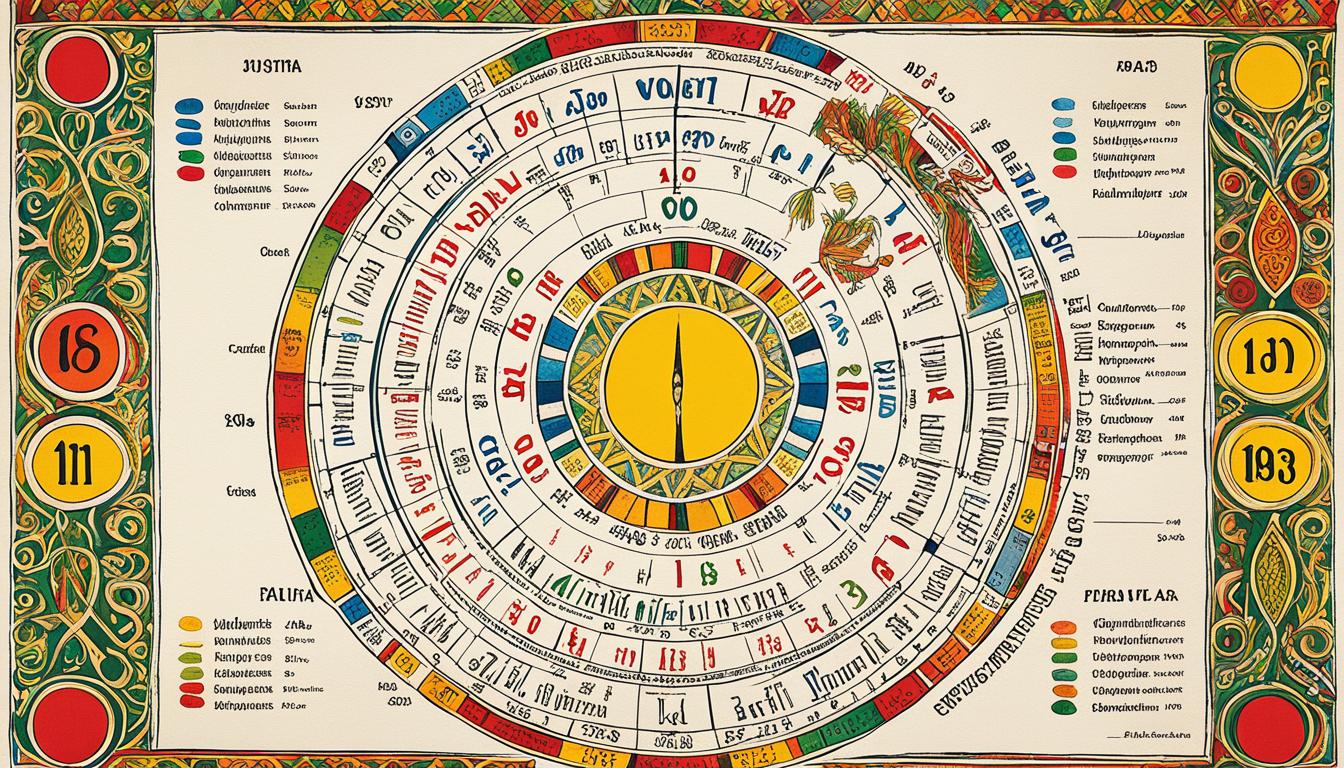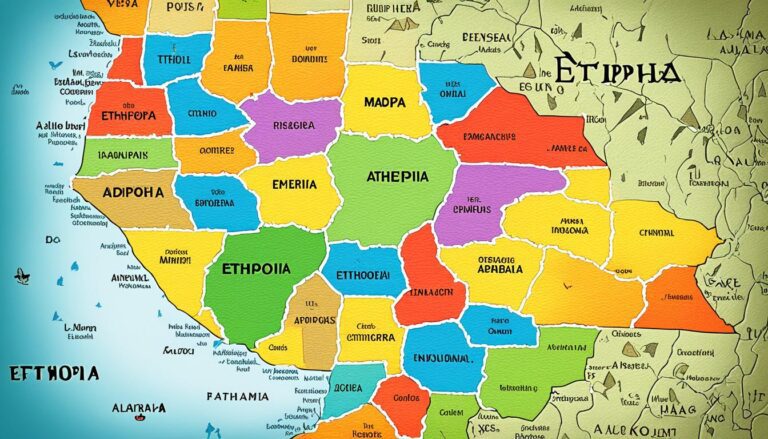Does Ethiopia Have 13 Months in a Year?
Did you know that Ethiopia follows a calendar with 13 months, unlike the standard 12-month calendar used by most countries? Yes, you read that right! Ethiopia, known for its rich cultural heritage and historical significance, has a unique calendar system that sets it apart from the rest of the world.
Key Takeaways:
- The Ethiopian calendar consists of 13 months, with an additional month known as the 13th month.
- It follows a different calculation for the birth year of Jesus Christ compared to the Gregorian calendar.
- The Ethiopian New Year falls on 11 or 12 September, depending on whether it is a leap year.
- Ethiopia’s unique calendar is an integral part of its cultural and religious traditions.
- Stay tuned to learn more about the fascinating aspects of the Ethiopian calendar and its significance.
The Unique Ethiopian Calendar
The Ethiopian calendar, also known as the Ge’ez calendar, is the official calendar of Ethiopia. It is used as both the civil and ecclesiastical calendar. The calendar is based on the ancient Coptic calendar and is also similar to the Julian calendar. It adds a leap day every four years without exception. The Ethiopian calendar has twelve months, each with 30 days, and an additional month, known as the 13th month, which has five or six days. The months of the Ethiopian calendar have unique names in Ge’ez, the ancient Ethiopian language.
Here is a table showing the names of the Ethiopian months:
| Month | Name in Ge’ez |
|---|---|
| 1 | Meskerem |
| 2 | Tikimt |
| 3 | Hidar |
| 4 | Tahsas |
| 5 | Tir |
| 6 | Yekatit |
| 7 | Megabit |
| 8 | Miazia |
| 9 | Genbot |
| 10 | Sene |
| 11 | Hamle |
| 12 | Nehase |
| 13 | Pagume |
Ethiopian New Year and Holidays
Ethiopia celebrates its New Year, Enkutatash, with great enthusiasm and festivities. Enkutatash, meaning “gift of jewels” in Amharic, is a significant holiday in the country. It is observed on September 11 in the Gregorian calendar, and on September 12 in leap years. The celebration marks the start of the Ethiopian New Year and is a time for rejoicing and new beginnings.
The Ethiopian New Year celebration is characterized by vibrant cultural traditions, community gatherings, and feasting. Families and friends come together to share meals, exchange gifts, and enjoy traditional music and dance. It is a time to reflect on the past year and set goals for the future.
In addition to the Ethiopian New Year, Ethiopia also celebrates various holidays that hold cultural and religious significance. Christian holidays such as Christmas and Easter are observed with solemn religious ceremonies, followed by joyous festivities. Islamic holidays like Eid al-Fitr and Eid al-Adha are celebrated by the Muslim community, bringing people together for prayers, feasting, and acts of charity.
These holidays are an integral part of Ethiopia’s diverse cultural tapestry, symbolizing unity and harmony among different religious and ethnic groups. They provide an opportunity for people to reconnect with their heritage, strengthen community bonds, and express gratitude for the blessings in their lives.
Ethiopian Holidays
| Holiday | Date | Significance |
|---|---|---|
| Enkutatash | September 11 (Gregorian calendar) / September 12 in leap years | Celebration of the Ethiopian New Year |
| Christmas | January 7 (Gregorian calendar) | Birth of Jesus Christ |
| Easter | Varies (based on the Orthodox calendar) | Resurrection of Jesus Christ |
| Eid al-Fitr | Varies (based on the Islamic calendar) | Celebration marking the end of Ramadan |
| Eid al-Adha | Varies (based on the Islamic calendar) | Celebration commemorating the willingness of Ibrahim to sacrifice his son |
Ethiopian Time and Date

Ethiopia has its own unique way of telling time and calculating dates.
The Ethiopian day is divided into two 12-hour slots, with the day starting at 06:00. This means that 06:00 is equivalent to 12:00 in Ethiopian time. Similarly, midnight is considered as 06:00 in Ethiopian time.
When scheduling appointments or events in Ethiopia, it’s important to keep this time difference in mind.
Additionally, the Ethiopian date is several years behind the Gregorian date due to alternate calculations in determining the birth year of Jesus Christ.
“Ethiopia has its own unique way of telling time and calculating dates.”
Ethiopia’s Independence and Resistance to Colonization

Ethiopia is a remarkable country that stands out as the only African nation that was never colonized by European powers. Throughout the late 19th and early 20th centuries, Ethiopia successfully resisted Italian colonization, showcasing its unwavering determination and spirit of independence.
“The Battle of Adwa was a crucial turning point in Ethiopian history, symbolizing the resilience and strength of the Ethiopian people.”
The Battle of Adwa, which took place on 1 March 1896, holds immense significance in Ethiopian history. Under the leadership of Emperor Menelik II, Ethiopian forces achieved a remarkable feat by defeating the Italian army. This victory at Adwa marked a major milestone in African resistance to colonization and became an inspiring catalyst for the Pan-African movement.
The triumph at the Battle of Adwa showcased Ethiopia’s unwavering resolve, serving as a powerful symbol of hope and unity for Africans across the continent striving for independence. The Ethiopian people’s resolute resistance against colonization remains a testament to their commitment to sovereignty and self-determination.
Key Takeaways:
- Ethiopia is the only African country never colonized by European powers.
- The Battle of Adwa, in which Ethiopian forces triumphed over the Italian army, holds significant historical importance.
- The victory at Adwa played a vital role in inspiring the Pan-African movement and the fight for independence.
Emperor Haile Selassie and Rastafarianism
Emperor Haile Selassie, who ruled Ethiopia from 1930 to 1974, holds a special place in the Rastafarian movement. After his coronation, Rastafarians saw him as the fulfillment of a prophecy in which a black king would be crowned. They believe that Selassie is a direct descendant of King Solomon and the Queen of Sheba. His image is often depicted in Rastafarian art and is revered as the Lion of Judah. Rastafarianism spread globally through the popularity of reggae music, particularly through the influence of Bob Marley.
Influence of Emperor Haile Selassie
The reign of Emperor Haile Selassie had a profound impact on the Rastafarian movement. Rastafarians saw him as a symbol of black power and liberation, embodying their beliefs and ideals. His speeches and actions inspired the Rastafarian community to embrace their African heritage and actively resist oppression.
“Look to Africa, when a black king shall be crowned, for the day of deliverance is at hand.”
This quote from Marcus Garvey, a Jamaican political leader and key figure in the Rastafarian movement, captures the significance of Emperor Haile Selassie’s coronation in 1930. Rastafarians interpreted this event as the fulfillment of Garvey’s prophecy and a signal that liberation was imminent.
Rastafarian Influence on Music and Culture
One of the most powerful ways in which Rastafarianism spread globally was through reggae music. Artists like Bob Marley, Peter Tosh, and Burning Spear used their music as a platform to spread Rastafarian teachings and raise awareness about social and political issues. Their lyrics echoed the messages of liberation, spirituality, and social justice that defined Rastafarianism.
- Bob Marley’s iconic song “Redemption Song” serves as an anthem for the Rastafarian movement, calling for freedom and self-determination.
- Peter Tosh’s album “Legalize It” challenged the criminalization of marijuana, which holds deep religious and spiritual significance for Rastafarians.
- Burning Spear’s lyrics in “Slavery Days” and “Marcus Garvey” pay tribute to African history and the struggle for African liberation.
Through their music, these artists sparked a global interest in Rastafarian culture and beliefs. The reggae genre became synonymous with Rastafarianism, amplifying its influence and fostering a sense of solidarity among followers worldwide.
| Emperor Haile Selassie and Rastafarianism | Key Points |
|---|---|
| Emperor Haile Selassie |
|
| Rastafarian Influence |
|
The Ark of the Covenant in Ethiopia
According to Ethiopian Orthodox tradition, the Ark of the Covenant, which is said to hold the tablets with the Ten Commandments, is housed in the Our Lady Mary of Zion Church in the city of Aksum. The church and its grounds are considered sacred, and only a select few individuals are allowed access to the Ark.
Legend has it that the Ark was brought to Ethiopia by the Queen of Sheba after her visit to King Solomon in Jerusalem. The Ark is a significant symbol of religious and cultural heritage in Ethiopia.
Conclusion
Ethiopia’s unique calendar with 13 months, its independence from colonization, and its rich cultural heritage make it a fascinating country. The Ethiopian calendar reflects the country’s historical and religious traditions, while its resistance to colonization and the legacy of Emperor Haile Selassie have shaped its identity. The presence of the Ark of the Covenant adds to the mystique and significance of Ethiopia’s cultural and religious beliefs.
Overall, Ethiopia stands out as a country with a distinct calendar, a resilient history, and a vibrant cultural heritage. The Ethiopian New Year and other holidays bring communities together, showcasing the diversity and unity found within the nation. With its rich history, tradition, and the significant contributions of individuals such as Emperor Haile Selassie, Ethiopia continues to captivate the world with its unique narrative.
Exploring Ethiopia’s calendar, its resistance to colonization, and its cultural landmarks like the Ark of the Covenant provides insight into the country’s deep-rooted traditions and the values held by its people. From ancient times to the present day, Ethiopia’s rich culture and history continue to inspire and fascinate visitors from around the world. Ethiopia is truly a treasure trove of customs, beliefs, and stories that contribute to its distinctive and captivating allure.






